Abstract
1. We investigated the potent 5-hydroxytryptamine (5-HT)-mediated vasorelaxation of the sheep pulmonary vein. Here we present evidence that this response is due to activation of 5-HT4 receptors. 2. 5-HT (1-1000 nM) caused concentration-dependent, maintained relaxations (pEC50 = 8.4 +/- 0.1) of isolated rings of sheep pulmonary vein pre-contracted with endothelin-1 (3 nM). 3. The relaxation response to 5-HT was unaffected by either removal of the endothelium or by inhibition of NO-synthase by NG-nitro-L-arginine (100 microM). 4. Ketanserin, methiothepin, methysergide and MDL 72222 at concentrations that selectively block 5-HT2, 5-HT1-like and 5-HT3 receptors respectively, had no effect on the concentration-relaxation curve to 5-HT. 5. ICS 205-930 (1-10 microM) competitively antagonized the concentration-relaxation curve to 5-HT with a pA2 of approximately 6.7. 6. Increasing the concentration of ICS 205-930 from 10 to 30 microM did not cause a further rightward shift of the 5-HT concentration-relaxation curve. The pEC50 of 6.50 for 5-HT in the presence of ICS 205-930 (30 microM) was taken as an estimate of the affinity of 5-HT for 5-HT1-like receptors since methiothepin (10 nM) unmasked further competitive inhibition of 5-HT in the presence of this concentration of ICS 205-930. 7. Other 5-HT agonists including 5-carboxamidotryptamine (5-CT), alpha-methyl-5-HT and BIMU 8 (but not 2-methyl-5-HT) also relaxed the pulmonary vein.(ABSTRACT TRUNCATED AT 250 WORDS)
Full text
PDF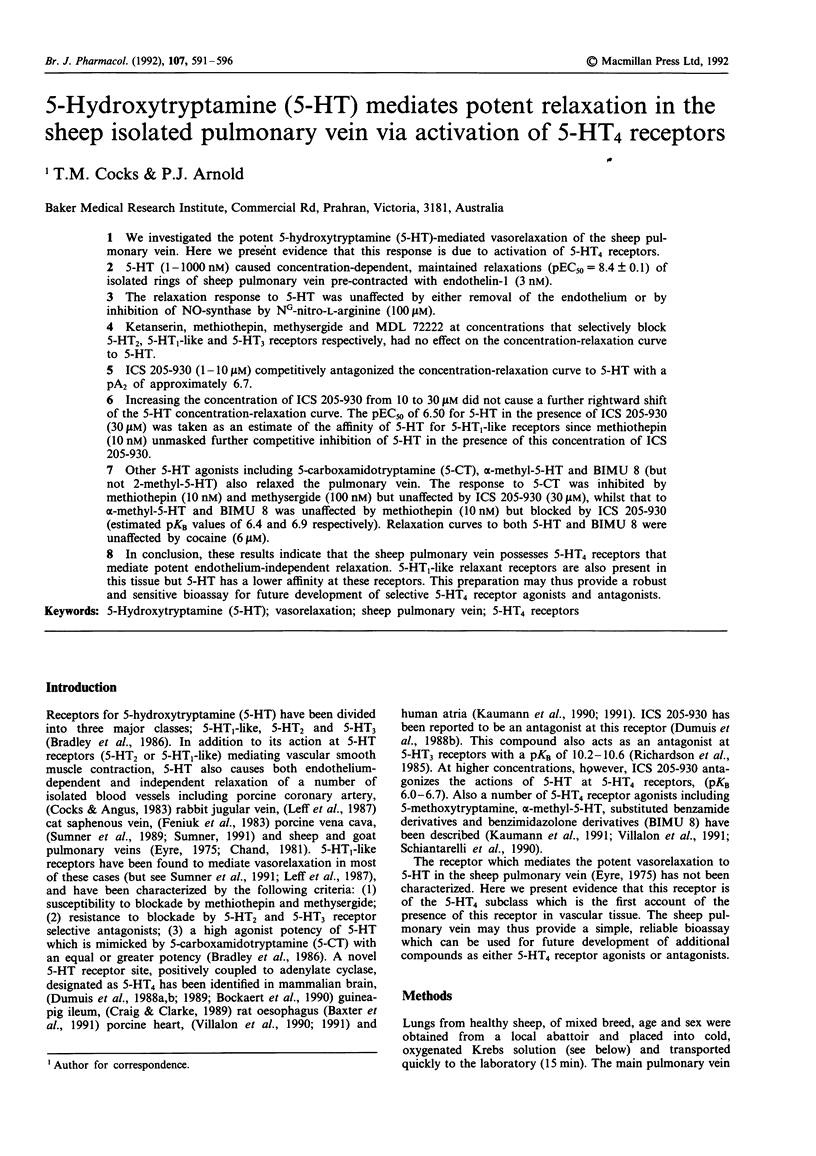
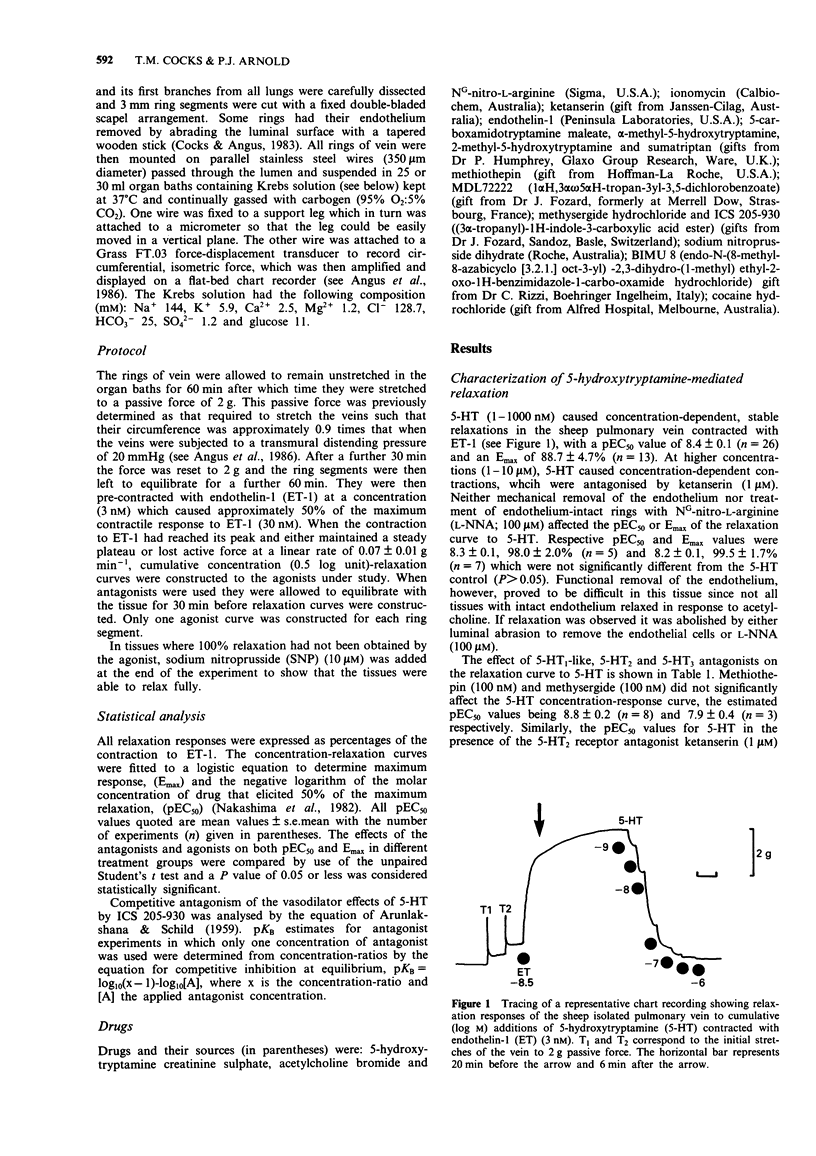
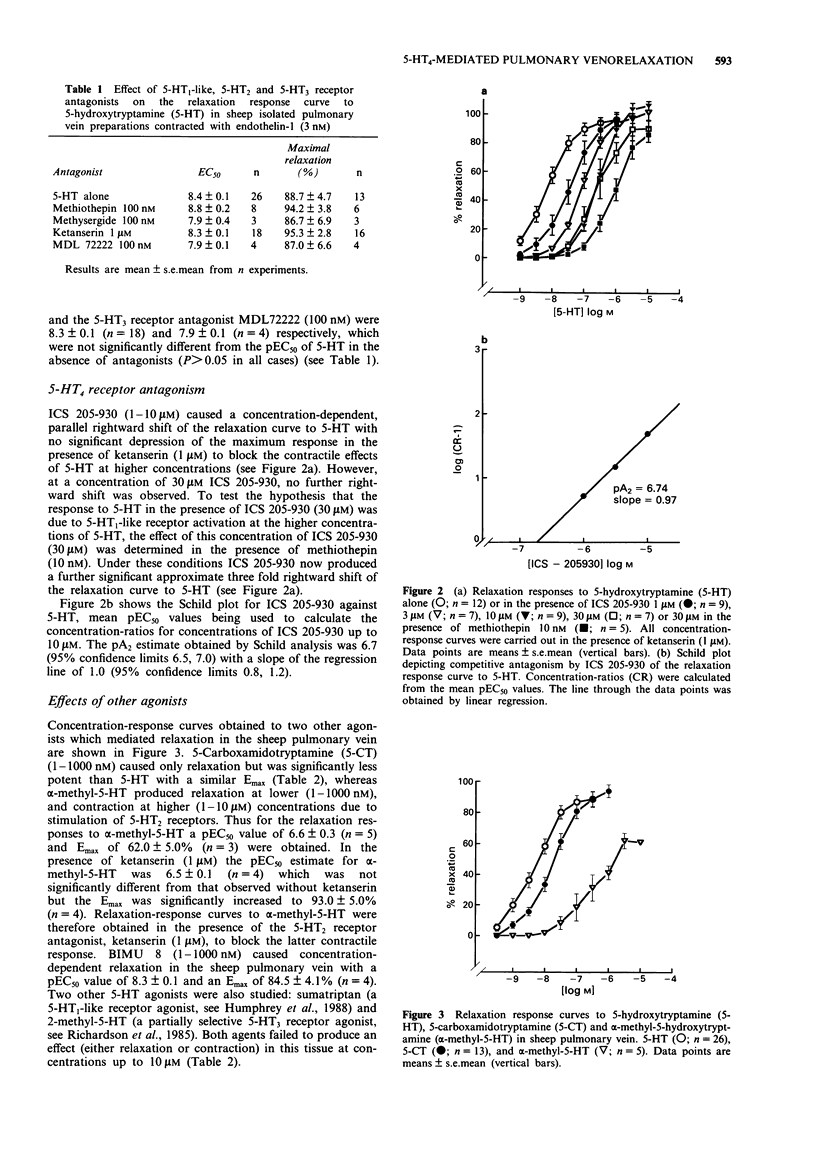
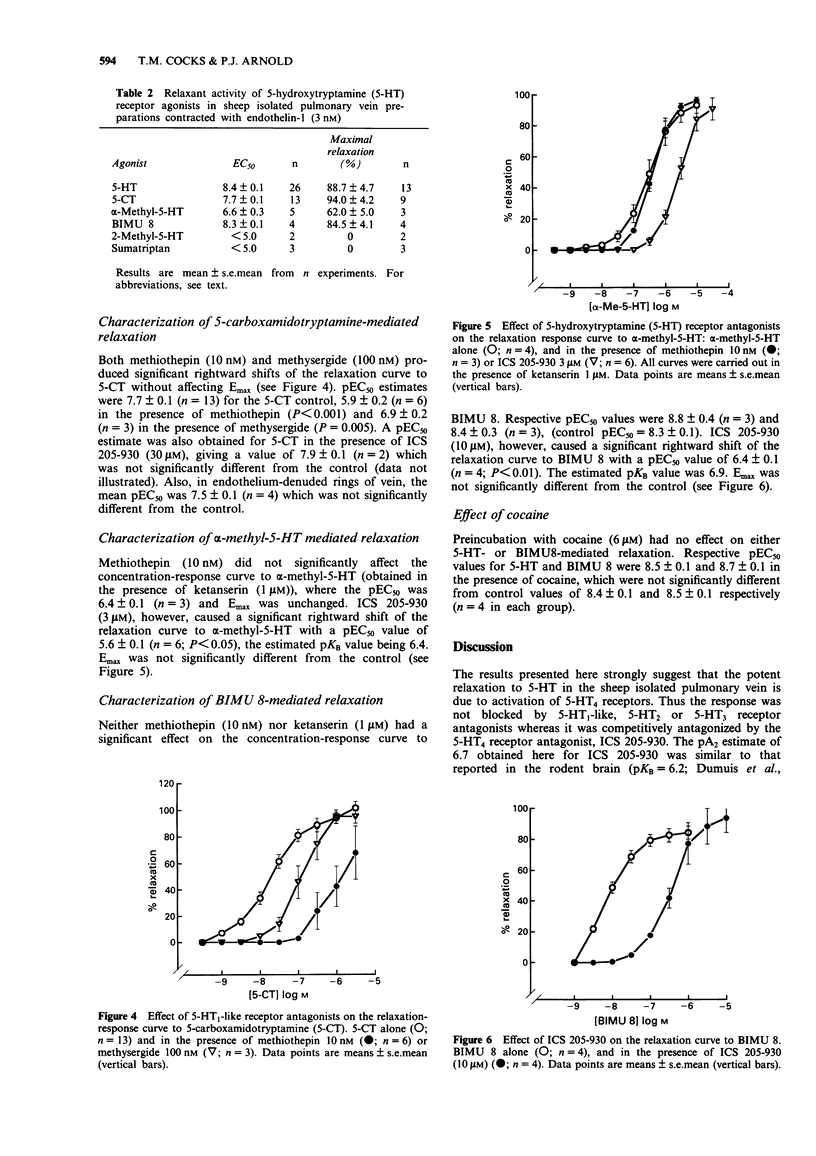
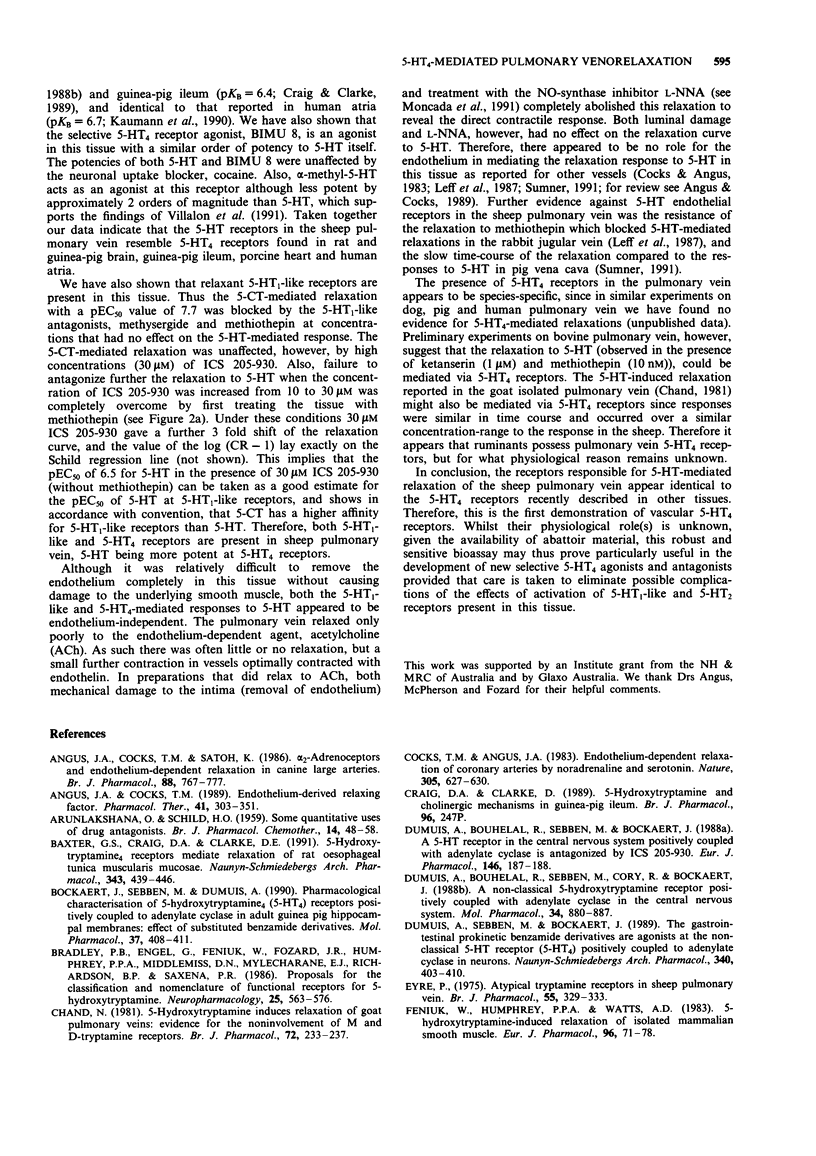
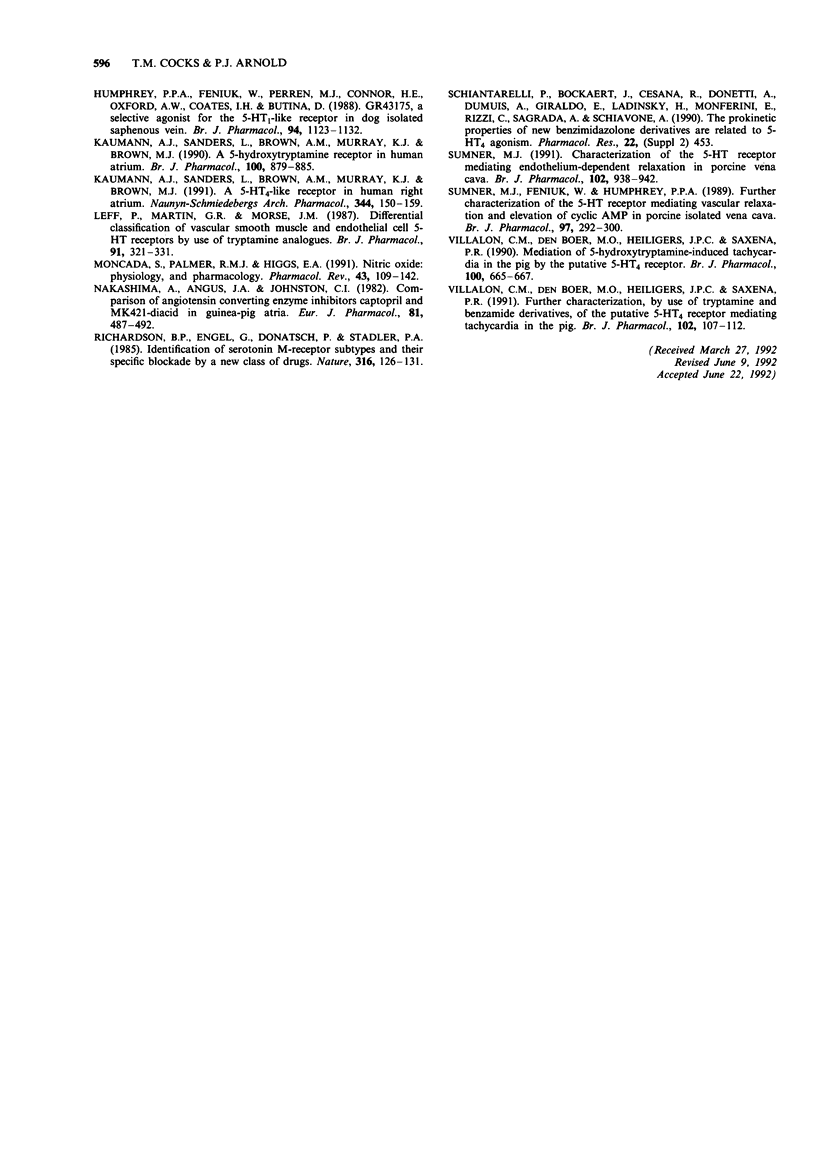
Selected References
These references are in PubMed. This may not be the complete list of references from this article.
- ARUNLAKSHANA O., SCHILD H. O. Some quantitative uses of drug antagonists. Br J Pharmacol Chemother. 1959 Mar;14(1):48–58. doi: 10.1111/j.1476-5381.1959.tb00928.x. [DOI] [PMC free article] [PubMed] [Google Scholar]
- Angus J. A., Cocks T. M. Endothelium-derived relaxing factor. Pharmacol Ther. 1989;41(1-2):303–352. doi: 10.1016/0163-7258(89)90112-5. [DOI] [PubMed] [Google Scholar]
- Angus J. A., Cocks T. M., Satoh K. Alpha 2-adrenoceptors and endothelium-dependent relaxation in canine large arteries. Br J Pharmacol. 1986 Aug;88(4):767–777. doi: 10.1111/j.1476-5381.1986.tb16249.x. [DOI] [PMC free article] [PubMed] [Google Scholar]
- Baxter G. S., Craig D. A., Clarke D. E. 5-Hydroxytryptamine4 receptors mediate relaxation of the rat oesophageal tunica muscularis mucosae. Naunyn Schmiedebergs Arch Pharmacol. 1991 May;343(5):439–446. doi: 10.1007/BF00169544. [DOI] [PubMed] [Google Scholar]
- Bockaert J., Sebben M., Dumuis A. Pharmacological characterization of 5-hydroxytryptamine4(5-HT4) receptors positively coupled to adenylate cyclase in adult guinea pig hippocampal membranes: effect of substituted benzamide derivatives. Mol Pharmacol. 1990 Mar;37(3):408–411. [PubMed] [Google Scholar]
- Bradley P. B., Engel G., Feniuk W., Fozard J. R., Humphrey P. P., Middlemiss D. N., Mylecharane E. J., Richardson B. P., Saxena P. R. Proposals for the classification and nomenclature of functional receptors for 5-hydroxytryptamine. Neuropharmacology. 1986 Jun;25(6):563–576. doi: 10.1016/0028-3908(86)90207-8. [DOI] [PubMed] [Google Scholar]
- Chand N. 5-Hydroxytryptamine induces relaxation of goat pulmonary veins: evidence for the noninvolvement of M and D-tryptamine receptors. Br J Pharmacol. 1981 Feb;72(2):233–237. doi: 10.1111/j.1476-5381.1981.tb09118.x. [DOI] [PMC free article] [PubMed] [Google Scholar]
- Cocks T. M., Angus J. A. Endothelium-dependent relaxation of coronary arteries by noradrenaline and serotonin. Nature. 1983 Oct 13;305(5935):627–630. doi: 10.1038/305627a0. [DOI] [PubMed] [Google Scholar]
- Dumuis A., Bouhelal R., Sebben M., Bockaert J. A 5-HT receptor in the central nervous system, positively coupled with adenylate cyclase, is antagonized by ICS 205 930. Eur J Pharmacol. 1988 Jan 27;146(1):187–188. doi: 10.1016/0014-2999(88)90503-1. [DOI] [PubMed] [Google Scholar]
- Dumuis A., Bouhelal R., Sebben M., Cory R., Bockaert J. A nonclassical 5-hydroxytryptamine receptor positively coupled with adenylate cyclase in the central nervous system. Mol Pharmacol. 1988 Dec;34(6):880–887. [PubMed] [Google Scholar]
- Dumuis A., Sebben M., Bockaert J. The gastrointestinal prokinetic benzamide derivatives are agonists at the non-classical 5-HT receptor (5-HT4) positively coupled to adenylate cyclase in neurons. Naunyn Schmiedebergs Arch Pharmacol. 1989 Oct;340(4):403–410. doi: 10.1007/BF00167041. [DOI] [PubMed] [Google Scholar]
- Eyre P. Atypical tryptamine receptors in sheep pulmonary vein. Br J Pharmacol. 1975 Nov;55(3):329–333. doi: 10.1111/j.1476-5381.1975.tb06935.x. [DOI] [PMC free article] [PubMed] [Google Scholar]
- Feniuk W., Humphrey P. P., Watts A. D. 5-Hydroxytryptamine-induced relaxation of isolated mammalian smooth muscle. Eur J Pharmacol. 1983 Dec 9;96(1-2):71–78. doi: 10.1016/0014-2999(83)90530-7. [DOI] [PubMed] [Google Scholar]
- Humphrey P. P., Feniuk W., Perren M. J., Connor H. E., Oxford A. W., Coates L. H., Butina D. GR43175, a selective agonist for the 5-HT1-like receptor in dog isolated saphenous vein. Br J Pharmacol. 1988 Aug;94(4):1123–1132. doi: 10.1111/j.1476-5381.1988.tb11630.x. [DOI] [PMC free article] [PubMed] [Google Scholar]
- Kaumann A. J., Sanders L., Brown A. M., Murray K. J., Brown M. J. A 5-HT4-like receptor in human right atrium. Naunyn Schmiedebergs Arch Pharmacol. 1991 Aug;344(2):150–159. doi: 10.1007/BF00167212. [DOI] [PubMed] [Google Scholar]
- Kaumann A. J., Sanders L., Brown A. M., Murray K. J., Brown M. J. A 5-hydroxytryptamine receptor in human atrium. Br J Pharmacol. 1990 Aug;100(4):879–885. doi: 10.1111/j.1476-5381.1990.tb14108.x. [DOI] [PMC free article] [PubMed] [Google Scholar]
- Leff P., Martin G. R., Morse J. M. Differential classification of vascular smooth muscle and endothelial cell 5-HT receptors by use of tryptamine analogues. Br J Pharmacol. 1987 Jun;91(2):321–331. doi: 10.1111/j.1476-5381.1987.tb10287.x. [DOI] [PMC free article] [PubMed] [Google Scholar]
- Moncada S., Palmer R. M., Higgs E. A. Nitric oxide: physiology, pathophysiology, and pharmacology. Pharmacol Rev. 1991 Jun;43(2):109–142. [PubMed] [Google Scholar]
- Nakashima A., Angus J. A., Johnston C. I. Comparison of angiotensin converting enzyme inhibitors captopril and MK421-diacid in guinea pig atria. Eur J Pharmacol. 1982 Jul 16;81(3):487–492. doi: 10.1016/0014-2999(82)90114-5. [DOI] [PubMed] [Google Scholar]
- Richardson B. P., Engel G., Donatsch P., Stadler P. A. Identification of serotonin M-receptor subtypes and their specific blockade by a new class of drugs. Nature. 1985 Jul 11;316(6024):126–131. doi: 10.1038/316126a0. [DOI] [PubMed] [Google Scholar]
- Sumner M. J. Characterization of the 5-HT receptor mediating endothelium-dependent relaxation in porcine vena cava. Br J Pharmacol. 1991 Apr;102(4):938–942. doi: 10.1111/j.1476-5381.1991.tb12280.x. [DOI] [PMC free article] [PubMed] [Google Scholar]
- Sumner M. J., Feniuk W., Humphrey P. P. Further characterization of the 5-HT receptor mediating vascular relaxation and elevation of cyclic AMP in porcine isolated vena cava. Br J Pharmacol. 1989 May;97(1):292–300. doi: 10.1111/j.1476-5381.1989.tb11953.x. [DOI] [PMC free article] [PubMed] [Google Scholar]
- Villalón C. M., den Boer M. O., Heiligers J. P., Saxena P. R. Further characterization, by use of tryptamine and benzamide derivatives, of the putative 5-HT4 receptor mediating tachycardia in the pig. Br J Pharmacol. 1991 Jan;102(1):107–112. doi: 10.1111/j.1476-5381.1991.tb12140.x. [DOI] [PMC free article] [PubMed] [Google Scholar]
- Villalón C. M., den Boer M. O., Heiligers J. P., Saxena P. R. Mediation of 5-hydroxytryptamine-induced tachycardia in the pig by the putative 5-HT4 receptor. Br J Pharmacol. 1990 Aug;100(4):665–667. doi: 10.1111/j.1476-5381.1990.tb14073.x. [DOI] [PMC free article] [PubMed] [Google Scholar]


